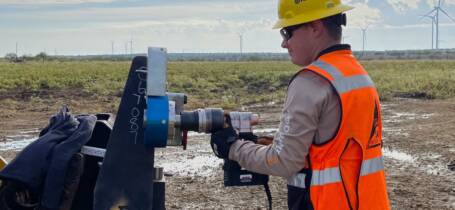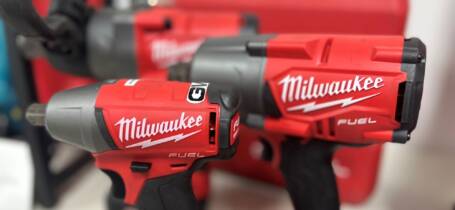![Your Guide to Pneumatic Vs. Electric Tools [and How to Choose]](https://www.gwyinc.com/wp-content/uploads/2024/05/Pneumatic-vs-Electric-Tools-625x267.jpg)
When choosing between pneumatic and electric tools for structural bolting applications, the decision goes beyond just power output. Factors like accuracy, speed, durability, noise level and long-term maintenance play a crucial role. While pneumatic or hydraulic tools have been a traditional choice in many industries that require high torque, advancements in electric tool technology have made them a viable alternative — especially for high-precision bolting applications like bridges, buildings and industrial projects.
Here, we discuss the similarities and differences, as well as the pros and cons of each type of tool, to help you decide whether pneumatic or electric power is right for your projects.
What Are Pneumatic Tools?
Pneumatic tools get their power from compressed air, which enables them to generate high torque. Also called air-powered tools, pneumatic tools are attached by a hose to an air compressor. Compressed air hoses are equipped with quick-change adaptor bits that enable rapid switching between tools.
Pneumatic tools are used for high-volume projects that require massive force, such as bridge construction, metalworking or chemical processing. They are also commonly used in industrial settings where air supply systems are already in place.
What Are Electric Tools?
Electric bolting tools use corded or battery-powered motors to deliver controlled torque with high accuracy. Modern electric wrenches are designed for ease of use, precision and durability, making them the preferred choice for structural bolting applications and projects that require more accuracy than an air-powered tool can deliver.
However, there are many jobs in which power is prioritized over accuracy; this is where pneumatic tools are preferred.
Pneumatic Tools: Pros & Cons
Pros of pneumatic tools
Punch: Due to their power, pneumatic tools are used for projects involving steel, stone and other heavy-duty materials. Depending on the specific type and model, the more compressed air at your disposal, the more power a pneumatic tool can deliver. Multiple tools can also be powered simultaneously with the same air compressor.
Tool cost: Though the cost of the tool itself is relatively low, pneumatic tools require a good deal of extra equipment to function, as well as more maintenance. (See Cons below.)
Speed: Since they tend to be less accurate than electric tools, air-powered tools are not favored for speed and accuracy, but rather for high torque output.
Cons of pneumatic tools
Equipment cost: Though pneumatic tools are relatively inexpensive, they require quite a few accessories, such as air compressors, hoses and adaptors. And buying “cheap” can cost you — longevity, energy consumption and worker safety all depend on the quality of the parts.
Durability: Pneumatic tools wear out quickly due to constant exposure to compressed air pressure, moisture and vibration. Components such as seals, gaskets and bearings deteriorate over time, leading to frequent replacements or repairs.
Maintenance: Pneumatic tools require regular servicing to function properly. Air hoses must be checked for leaks, compressors need draining and moving parts require lubrication. Failing to maintain them can lead to reduced efficiency, safety hazards and premature tool failure.
Noise: When in operation, air compressors can be extremely loud, reaching up to 92 decibels. Even the quietest models make themselves known at 60 decibels — about as loud as a crowded restaurant. Without proper protective gear, prolonged exposure can cause tinnitus and hearing damage.
Vibration: Excessive vibration in hand-operated pneumatic tools can lead to joint injuries, muscle fatigue and long-term conditions such as Hand-Arm Vibration Syndrome (HAVS) if used frequently.
Portability: Air compressors and their accessories can be heavy and unwieldy. Even the smallest compressors can weigh 35 pounds or more, making transportation cumbersome.
Hoses and flexibility: Using compressed air means always being tethered to an air hose, which can be rigid and restrictive. Poor-quality hoses increase the risk of leaks, pressure drops and operator fatigue.
Oil hazard: Since all pneumatic tools require lubricating oil, they carry the risk of spraying oil over your workspace, creating slip hazards and contamination concerns.
Environmental factors: Pneumatic tool performance is affected by temperature and weather. Cold temperatures reduce air pressure efficiency, leading to lower torque output and potential freezing of moisture in the airline, which can damage internal components.
Electric Tools: Pros & Cons
Pros of electric tools
Portability: As long as you have an extension cord and an electricity source, electric tools can be transported and used anywhere. Battery-powered electric tools eliminate this need altogether, though it’s always wise to bring extra batteries and/or a charger.
Maneuverability: The freedom that comes from not being tethered to a compressor makes electric tools the preferred choice for jobs requiring a large range of motion. Electrical cords are also much more flexible than air hoses, reducing workspace restrictions.
Noise: Electric tools are far quieter than pneumatic tools, as they run at a constant speed without excessive rattle or impact. While some battery-powered impact wrenches do create noise when tightening bolts, those are mainly used for snugging and not final torque applications.
Accuracy: Electric tools provide high levels of precision, making them the better choice for applications that require consistent torque and repeatable results.
Durability: Electric tools are built with fewer moving parts than pneumatic tools, leading to less wear and tear over time. High-quality electric wrenches, like those sold by GWY, are engineered to withstand demanding job site conditions while maintaining performance over extended use.
Maintenance: Compared to pneumatic tools, electric tools require less frequent maintenance. There is no need for air hoses, compressors, or constant lubrication. Regular inspections should still be performed to check cord integrity, motor performance, and battery condition, but overall, electric tools require less upkeep and have a longer service life when properly used.
Cons of Electric Tools
Equipment hazard: Power cords can present a tripping hazard, and the presence of water near an electric tool introduces a shock risk. When using a generator, there is also the added concern of flammable fuel storage in the workspace.
Battery Life: With a battery-powered tool, uptime is limited to battery capacity. To complete high-volume jobs on a deadline, workers must have extra batteries on hand or be able to switch to a corded electric tool. Fortunately, many modern battery platforms allow interchangeability between tools using the same battery type, reducing downtime.
Corded vs. Battery-Powered Electric Tools
Whether you choose a corded or battery-powered electric tool depends on the situation. Corded tools deliver continuous power, provided electricity is available and the workspace is within reach of an outlet. Corded tools can provide the same amount of power for the duration of their use, since their power reserve isn’t limited. And corded tools aren’t just for long jobs; they also tend to be more powerful and better suited for high-torque applications like structural bolting.
Battery-powered tools are ideal for small jobs, both in size and volume. They also offer a measure of portability that corded tools can’t, simply because they don’t need to be attached to their power source; they are perfect for hard-to-reach areas or locations without easy access to power. However, the longer a job takes, or the higher the project volume, the less force a battery-powered tool may be able to deliver, and stopping to charge depleted batteries can cost you valuable uptime. That said, modern high-capacity lithium-ion batteries and quick-charge systems have made battery tools more viable for higher-volume jobs than in the past.
When Does a Pneumatic Tool Make More Sense?
Pneumatic tools are typically the preferred choice for machine shops and auto body work, as well as other industrial settings where high-speed, repetitive torque is required. In these environments, some of the best pneumatic tools for heavy-duty jobs include impact wrenches, grinders and air-powered drills. However, they are not appropriate for jobs requiring high precision, nor are they particularly portable.
Jobs that require pneumatic tools include:
- Auto repair and assembly: Used in tire shops, auto manufacturing and bodywork for tasks like impact wrenching and sanding.
- Manufacturing plants: Frequently used in assembly lines where tools operate at high speeds with compressed air systems in place.
- Industrial maintenance: Pneumatic tools may be found in factories, refineries or heavy machinery servicing, where high torque output is needed and air compressors are already installed.
- Metal fabrication: Used for grinding, cutting and shaping metal parts.
When Does an Electric Tool Make More Sense?
Electric tools are the preferred choice for jobs requiring accuracy, consistency and ease of use. With advances in electric tool technology, their power capabilities now rival those of pneumatic tools in many applications. Additionally, electric tools offer better torque control, reduced noise levels and greater portability — especially for structural bolting jobs.
However, for high-volume tasks, having backup batteries or switching to a corded option ensures continuous operation.
Jobs that require electric tools include:
- Structural steel construction: Used for bridges, buildings and industrial facilities where bolts must be tightened to precise specifications.
- Commercial construction: Essential for steel erection, HVAC installations and mechanical fastening requiring controlled torque application.
- Remote job sites: Battery-powered electric tools provide unmatched portability, making them ideal for off-grid locations without easy access to compressed air or power outlets.
- High-precision bolting applications: Some of the best electric tools for precision work include electric torque wrenches and Turn-of-Nut wrenches, which ensure bolts are tightened to RCSC and AISC standards with minimal variation, reducing rework and installation errors.
- Large-scale industrial projects: Commonly used in energy infrastructure, renewable energy projects and plant construction, where torque accuracy and reliability are critical.
Choosing Between Pneumatic and Electric Tools: A Quick Decision Guide
Selecting the right tool for the job depends on accuracy, power availability, portability and long-term efficiency. Use the checklist below to determine whether pneumatic or electric tools are the best fit for your project.
Choose pneumatic tools if:
☐ You already have an air compressor system in place
☐ The job requires high-speed, repetitive tasks with less concern for precision
☐ The work is being done in a fixed location like a machine shop or assembly line
☐ You need high torque output but don’t require tight accuracy tolerances
☐ You are working in auto repair, manufacturing or industrial maintenance
☐ You are prepared for higher maintenance needs (air hoses, compressor upkeep, lubrication)
Choose electric tools if:
☐ The job requires precision, repeatable torque or compliance with tight specifications
☐ Portability is a priority, and you need to work without an air hose or compressor
☐ The worksite does not have an air system, or air supply is inconsistent
☐ You want a quieter, lower-maintenance and more ergonomic tool
☐ The project involves structural bolting, construction or fieldwork
☐ You need a more durable tool with fewer moving parts
Still unsure? If your job requires high torque and portability, a corded or battery-powered electric tool may be the best solution. The experts at GWY can help you select the right tool for your specific application.
The Future of Tools Technology
Despite improvements in electric tool capabilities and battery technology, pneumatic tools will likely always have a place — especially in legacy industries where compressed air systems are already integrated. Air-powered tools have been a staple for decades, making their foothold in manufacturing, auto repair and assembly lines difficult to dislodge.
However, the industry is shifting. Advancements in lithium-ion battery technology, brushless motors and precision torque control have significantly narrowed the performance gap between pneumatic and electric tools. As more professionals recognize the advantages of electric tools — including greater accuracy, lower noise levels, reduced maintenance and portability — the reliance on pneumatic tools will likely decline.
In structural bolting, commercial construction and industrial applications, electric tools are already outpacing pneumatic options. As battery technology continues to improve, the future will see even greater adoption of cordless electric tools capable of delivering consistent, high-torque performance without the drawbacks of air compressors and hoses.
As a leader in the large-scale construction space, GWY is invested in future developments in electric tool technology. We specialize in electric bolting solutions, offering a range of shear wrenches, Turn-of-Nut wrenches and electric torque wrenches that outperform pneumatic tools in nearly every aspect.
To discuss which types of tools are most appropriate for your project, get in touch with us today.



